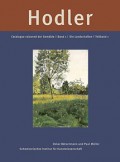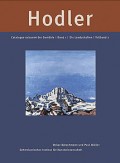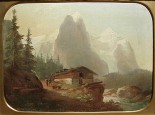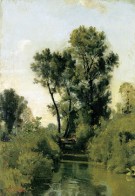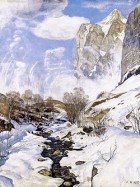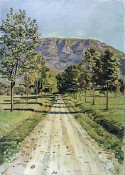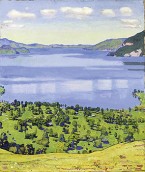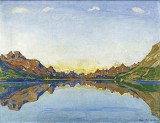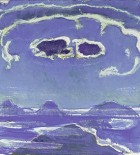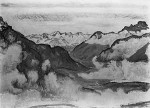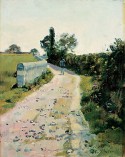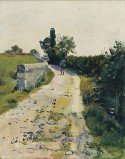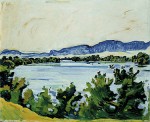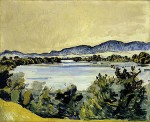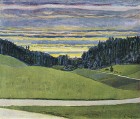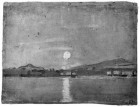The browser will either open the file, download it, or display a dialog.
Ferdinand Hodler. Catalogue Raisonné der Gemälde, Die Landschaften
Oskar Bätschmann and Paul Müller, with contributions by Regula Bolleter, Monika Brunner, Matthias Fischer and Matthias Oberli.
Zurich: Swiss Institute for Art Research/ Scheidegger & Spiess, 2008.
Volume 1: 262 pp.
Volume 2: 366 pp; numerous color & b/w illus; index.
CHF 640 (ca. $580)
ISBN 978-3-85881-244-5
Online access at: http://www.sik-isea.ch
Cost for access code to web-based catalogue: CHF 80 (ca. $72)
Considered a leading figure in modern European art during his lifetime, Ferdinand Hodler (1853 – 1918) was Switzerland's first great modern painter. He was the one who managed to break away completely from the provincialism of his home country while remaining there, whereas the other Swiss artists of international stature like Jean-Etienne Liotard, Henry Fuseli, Charles Gleyre, Arnold Böcklin, Alberto Giacometti or Le Corbusier all worked a considerable time abroad. Hodler's career was European and marked by both scandal and success, while his life and work garnered early recognition well into the 1920s with a revival during World War II. As a consequence of the general revisionism in the history of nineteenth century art, Hodler has received ever increasing scholarly attention since the 1970s, not least because Americans took an interest in him: In 1972, Peter Selz organized the first retrospective of the artist in the United States in Berkeley, California, Cambridge, Massachusetts, and New York, while Robert Rosenblum gave Hodler an exceptional position equal to Edvard Munch in his trailblazing Modern Painting and the Northern Romantic Tradition of 1975.[1]Sharon Hirsh followed shortly afterwards with the first monograph on the artist written in English in 1982, and with her detailed study of Hodler's Symbolist Themes in 1983.[2] Three years later, Reinhold Heller re-evaluated the fine group of Hodler paintings that came to the Art Institute of Chicago already in 1926,[3] while the following year, some of Hodler's landscapes were shown with considerable success in Los Angeles, Chicago and New York.[4] His paintings were also a highlight in the exceptional exhibition From Liotard to Le Corbusier at the High Museum of Art in Atlanta in 1988;[5] and in 1995, the Cincinnati Art Museum organized the traveling show Ferdinand Hodler: Views & Visions that went to New York, Toronto, and Hartford, Connecticut.[6] At the same time, American and European institutions showed or acquired Hodler's work in increasing numbers, and thus helped the artist to re-enter the Western canon of Art.[7] Textbooks such as Petra ten-Doesschate-Chu's Nineteenth-Century European Art of 2003 (1st edition) and Robert Rosenblum and H. W. Janson's revised and updated edition of 19th-Century Art of 2005 include Hodler, although these mainly explain him through his symbolist compositions.[8] It is, however, his landscapes, that, in his own words, bring out "nature's essential beauty",[9] and it is these that form the main body of Hodler's painted work that now fills the first two volumes of the new catalogue raisonné that Paul Müller and his collaborators have compiled over the last decade, supervised by Oskar Bätschmann and published by the Swiss Institute for Art Research in Zurich (figs. 1 and 2). The catalogue brings to fruition a massive project that was prepared in the 1980s under the visionary leadership of the late Hans A. Lüthy, and which was begun in 1999. It will be followed in 2012 by volume two, covering Hodler's portraits, and in 2014 by volume three which will include his figurative paintings, symbolist compositions and history painting. A last volume offering a detailed biography, a wealth of source material and documents is scheduled for 2015.
Hodler's painted œuvre had already been catalogued and published by his biographer and friend, Carl Albert Loosli, in his still authoritative 1924 monograph on the artist.[10] This basic catalogue lists 518 landscapes. In 1941, Werner Y. Müller re-catalogued Hodler's landscape paintings and increased their number to 630.[11] Given the patchy and contradictory information and chronological errors in these rather rudimentary catalogues, and the increasing interest in Hodler's work since the late 1960s, this new publication has been treated with an unusual degree of welcoming anticipation. For the first time, we are able to review an important body of Hodler's work in oil: all his landscapes covering his entire career from his formative years as an apprentice to his late visionary work in which he touched upon the modernism of the pre-World War I years.
Hodler, who was born the same year as Vincent van Gogh, came from a humble background, was orphaned at the age of fourteen, and was first trained with his step-father, a house-and sign-painter. At the age of fifteen, he was sent to Thun to become an apprentice to Ferdinand Sommer, a painter who produced not very sophisticated mountain views for the then growing tourist industry. A typical example of Hodler's early production from this time is his Chalet with Well- and Wetterhorn (fig. 3). Hoping to break out of his provincial existence, Hodler walked to Geneva at the end of 1871 without speaking a word of French, but hoping to achieve an artistic career. At that time, Geneva was Switzerland's artistic center with a proper academy and an art museum, and it was there that Barthélemy Menn noticed eighteen-year-old Hodler copying in the Musée Rath, and allowed the novice painter to study with him free of charge between 1872 and 1877. Menn, who was a friend of Camille Corot and a former pupil of J.-A.-D. Ingres, practiced the paysage intime and plein-air painting which, together with his theoretical teaching, had a defining impact on Hodler's art. He liberated Hodler from the conventional and picturesque, and taught him to build his art on measurement, drawing, and a close observation of nature. He also introduced him to the concept of parallelism, a system of formal repetition and symmetry which was, in Hodler's own words, "an element of order" inherent in nature, a reflection of the underlying harmony of creation, and which imparted a philosophical dimension to his art.[12]
Above all, Hodler would learn from Menn the paysage intime, of which his Mill Brook near Langenthal of 1876 is a good example (fig. 4). Here he explored the tonal values of different greens and browns, and deftly observed the play of light and shadow on the water's surface. The discreet spot of red on the figure in the background is an element for which Menn may have acted as a mediator between Corot and the young Swiss, for in Hodler's early years, there were only very few paintings by the French master publicly accessible in Geneva, and certainly none characteristic of Corot's early Barbizon landscapes that Hodler might have used as a reference or that he might have seen.[13]
In need of cheaper living accommodation and eager to study the great masters, Hodler went to Madrid for a year in 1878, after which he returned to Geneva and became an assistant to Edouard Castres, the successful panorama painter. At that time, his landscapes still incorporated elements from French plein-air painting while simultaneously moving towards his own artistic idiom, manifest in stronger and crisper colors, solid structures within a landscape and a lighter tonality. He also stopped using staffage, concentrating instead on the topography of a landscape. Hodler's Avalanche of 1887, for example, contains no figures, only the Schwarze Lütschine, a mountain stream near Grindelwald, with the rising Northern rock face of the Mettenberg and Wetterhorn to the right, and the powdery snow of an avalanche that has just hit the valley in the central background (fig. 5). Based on open air studies, this canvas shows massive mountains rising up from the valley ground, while later, the artist would paint only their peaks from a height.
In the 1890s, Hodler caused his first major scandal in Geneva with his seminal masterpiece, The Night, that would later earn him international recognition at the Salon du Champs-de-Mars in Paris, and that, from 1900 onwards, together with a group of highly ambitious Symbolist compositions, would establish his international fame. In those last years of the fin-de- siècle, he also won the competition for the Weapons Hall murals of the newly erected Swiss National Museum in Zurich with the large history painting The Retreat from Marignano of 1515. It was this piece that caused Switzerland's first national art scandal and at the same time established Hodler as a major force in modern art. In those rapturous years, he painted several outdoor scenes filled with sunlight and the transitory quality of atmosphere such as The Street to Evordes and the Sunny Country Lane both painted around 1890 (figs. 6 and 13). His larger landscapes, however, were charged with Symbolist strains evocative of a pantheistic awe for the boundless universe.
Hodler would regularly go to study the location of a chosen landscape and later finish what he had started enplein-air, or reproduce it in his studio from sketches. He also used the Dürer plane as evidenced by tracings and a few drawings, in a bid for precision and accuracy in the subject he was recording.[14] With respect to topographical detail, on the other hand, he would effect a formal stylization by using symmetrical compositions and parallel structures either along a horizontal axis as in The Street to Evordes or along a vertical axis as in his Lake Silvaplana (figs. 6 and 8). He would also repeatedly opt for curved lines either of the near shore or the sweep of some distant mountains, while clouds are shown reflected in the water of the lake as in his View of the Lake of Thun from Finel and Lake Silvaplana (figs. 7 and 8).
In his mature landscapes from 1904 onwards, he heightened the intensified simplification of a given topography through reflection and symmetry, and achieved unity by echoing what he referred to as "the eternal elements of nature."[15] Perhaps the most iconic of these mature landscapes is his 1908 Eiger, Mönch and Jungfrau in Moonlight, painted almost entirely in different blues on a square canvas (fig. 9). It shows Switzerland's three most majestic mountain peaks emerging from the misty depths of deep alpine valleys. Floating in the center of the picture are two dark clouds that cover the moon and are thus outlined by bright white rings caused by the reflection of the celestial body they hide. Above them opens a wide crescent of clouds that also capture the moonlight at their contours, and fuse into playful arabesques. The chosen format, as Paul Müller had observed, contradicts the human range of vision by limiting the illusion of space.[16] The painting's evocative power and degree of abstraction is reinforced in this sublime composition and lends weight to the claim that Hodler counts among the greatest landscape artists.
Believing that a landscape painter should render "a magnified, simplified nature, freed from all irrelevant details", Hodler elevated his late work to a new dimension to distinguish it from anything he had previously attempted.[17]
Eliminating everything incidental, irregular or anecdotal, and suppressing aerial and chromatic perspective, he painted his last views of Lake Geneva and the Savoyard Alps from his sickroom at Geneva's Quai du Mont Blanc in different weather conditions and at all times of day. Painting in loose broad brushstrokes on wide horizontal canvases, he combined parallelism with reduced color schemes, and thus transformed the mountain chain in the distance into a dark silhouette that functions as a contrasting axis between the glowing sky and its brilliant reflection on the surface of the lake (fig. 10 and 11). The painting in the collection of Emily Rauh Pulitzer, which is arguably the finest Hodler in the United States, is a prime example, in blue and gold, of this new radical vision that pushed landscape painting to the verge of abstraction and dissolves everything into color and space (fig. 11). Oskar Bätschmann's and Paul Müller's new catalogue raisonné presents for the first time the complete series of all eighteen late landscapes in color, and thus opens up a panorama of Hodler's art that has never before been seen in its entirety.
The publication appears in two volumes that together cover well over 620 printed pages; the catalogue entries can also be accessed electronically upon purchase of the printed edition.[18] The printed volumes offer a wealth of both basic information and critical insight in the introductory essays by Bätschmann and Müller on various aspects of Holder's landscapes, their sources, development and reception; they are similarly rich in the individual catalogue entries, listing technical data, provenance, previous scholarship, all exhibitions in which the pictures were shown, and an analytical discussion by the authors. The third section contains numerous maps recording all the places where the artist painted his landscapes, a list of every exhibition up to 2007 in which landscapes by Hodler were shown, a concise list of every archive, private or public, known to the authors, containing documentary material on the artist and his works, and an exhaustive bibliography listing every publication used for this catalogue up to January 2008. To this is added a concordance to the general catalogue by Loosli of 1924 and to the landscape catalogue by Müller of 1941, an index of all titles, an index of geographical names and an index of personal names and institutions.
The most innovative part of the project, however, is the ingenious webpage which is constantly upgraded and which allows for cross comparisons between paintings that have been shown in the same exhibition, included in the same publication, or have the same title or date. It also has useful search tools for provenance and present whereabouts, which opens up new venues for researchers and curators. The illustrations on the web version are always in color if a work has been accessible to the Swiss Institute for Art Research, and are, in most cases, excellent and true to the originals whereas in the printed catalogue color illustrations tend to be too dark. The authors and the Swiss Institute for Art Research deserve acclaim for this effort. Few sites have published catalogues of material culture in book and web form. Yet, digital catalogues of this sort are an excellent way to make information easily available to scholars and interested members of the public alike. Thus, both web version and printed edition make this new catalogue raisonné a landmark in Hodler studies and Swiss art.
As mentioned above, the printed catalogue is divided into three sections: the first lists all landscapes and animal paintings that the authors consider to be authentic. They are numbered and include 599 entries for landscapes and 27 entries for animals, mainly bulls, cows and donkeys. The second section lists 52 paintings whose authorship is contested; these are marked with a D (for douteux/ doubtful). The last section is dedicated to all known forgeries and erroneous attributions, which total 70, and it identifies these works with an R (for refusé/ rejected). While the first section illustrates every painting in color, unless it has been lost or its present whereabouts is unknown, the last two sections reproduce the dubious and forged paintings in black and white. Paul Müller has probably seen 90% of all the Hodler paintings and he highlights nuances of each. Hence, the best entries of the catalogue are in my opinion those written by him, because intimate knowledge of the work itself together with the circumstances of its creation and later history are presented clearly and concisely.
The chief value of this catalogue raisonné lies in its overview of a vast œuvre in which certain paintings have long been lost from view, others over exposed and many mis-titled or misdated. Accordingly, the authors had first to establish the proper titles of the paintings by identifying the landscapes they depict. They then had to establish the chronology, sometimes with the help of technological examination carried out by the Department of Conservation and Technology at the Swiss Institute for Art Research. Additional help came from the archive of Carl Albert Loosli that had for a long time been inaccessible and that led to several new discoveries, among them Hodler's early work Chalet with Well- and Wetterhorn (fig. 3),[19] and The Ally of Chestnut Trees near Biberist which was originally a gift to Oscar Miller, one of the artist's first collectors.[20] The catalogue raisonné also includes those paintings that have been lost in the course of history such as the Rhone valley with Dents du Midi, which was once in the Niedersächsischen Landesmuseum in Hannover but destroyed in World War II (fig. 12).[21]
The paintings are all listed in chronological order, which is extremely helpful and allows for a better understanding of the artist's working process, as well as for a comfortable assessment of his series and multiple variations. Over the years, Hodler returned several times to some motifs, to observe specific atmospheric conditions and changes of light and color at different times of day and in different seasons of the year. Sometimes he would simply paint different versions of the same view, or produce obvious replicas in his studio after pictures done en plein air; at other times he would return to a specific spot at a much later date to re-examine the landscape he had once successfully captured. When painting a replica, Hodler would trace the original composition and reproduce it faithfully, or in some cases modify only very slightly.[22] To maintain, however, that variations and repetitions in Hodler's body of landscape paintings were due to pecuniary concerns falls short of the truth, although in some cases it may well have been the driving force. Whatever the reason, Hodler's œuvre contains a vast number of repetitions and variations such as two Sunny Country Lanes (fig. 13),[23] our Streets to Evordes (fig. 6),[24] six views of the Grand Muveran,[25] seven views of the Lake of Geneva with Swans,[26] and eleven views of the Lake of Geneva from Chexbres,[27] some of which Hodler painted at different stages in his career. The record, however, is held by the thirty-three views Lake of Thun with the Stockhorn,[28] mostly produced between 1912 and 1913.
In view of these findings, one might be tempted to assume a serial approach to landscape painting as with Claude Monet's haystacks, poplar trees, and water lilies. Yet Hodler seems to have done some of his variations less systematically than Monet, and therefore not only in view of some commercial objective, but rather by chance and depending on his mood. It would be interesting and helpful for future scholars to know what prices his paintings have achieved during his lifetime, and whether Hodler would have charged the same for the first version of a landscape as for its repetition or copy. The archives of Hodler's dealer Galerie Moos in Geneva, as well as the archives of Paul Cassirer and Justin Thannhauser, should all have records of the selling prices of his paintings; the lack of sale prices may be one of the weaknesses of the new catalogue raisonné. Only a broad cross-section of Hodler's sale prices will allow us to understand the full significance of his variations and repetitions; at present they have to be gleaned from random information in early auction and exhibition catalogues and from the artist's letters and sketchbooks, though Regula Bolletter's forthcoming paper on Hodler's financial situation will fill this gap and lead to new discoveries and insights.[29]
Particularly fascinating is the section on fakes and forgeries. The existence of various versions of the same landscape can lead to confusion and erroneous identifications, which is why provenance and questions of authenticity are at the heart of this catalogue raisonné's authority. Paul Müller and his team have been very careful in distinguishing which past verdicts on authorship had to be revised as with the widely traveled and published River landscape of theAare near Solothurn from the famous Schmidheiny collection (fig. 14).[30] Here the fake was mistaken as authentic – and even toured the US with other Hodler landscapes in 1987[31]—until the original painting re-surfaced in 2003 (fig. 15) (417, 516-517).[32] Müller and his collaborators also note explicitly when statements of ownership are only assumptions and when a date or authorship can be corroborated by photographs or published sources. This is the case of the Jungfrau from Isenfluh that Werner Y. Müller, in 1941, dated to 1908 on stylistic grounds.[33] In his research for the new catalogue, however, Paul Müller discovered the painting in a photograph from the famous 1904 exhibition at the Vienna Secession, which confirmed the earlier dating by Loosli to 1902 (257-258).
Yet, in a handful of cases one might be surprised why a certain work has been accepted as authentic rather than put into the dubious-section, while others from the latter would appear to deserve a place among the authentic. One of these intriguing cases is the Country Road in the Vallée de Joux,[34] which only kept its status because scientific tests confirmed that the initial layers of paint were executed in a way that is typical of Hodler's style, while it remains unclear as to who spoiled the painting with extensive "restoration" and over-painting (221-222). Another puzzling case is an Evening near Schnittweierbad[35] (fig. 17): with its undefined green parts for the grassy hills and the horizontal bands of acidic colored clouds contrasting with the dark forests on both sides of the valley it sits - in spite of its impeccable provenance - rather uncomfortably among the rest of Hodler's authentic work, and renders unsatisfactory the scanty catalogue entry (250). Conversely, the Full Moon over the Lake of Geneva (fig. 18)[36] which was stolen from the art gallery in Sarajevo during the civil war in 1993, has been placed among doubtful works (485) although it is strikingly consonant with other views of Lake of Geneva at Night such as catalogue numbers 93 to 95 (136-137).
What scholars, dealers and curators learn from this section in general, however, is that "excellent provenances" or histories of ownership are not a guarantee for authenticity, as many would like to believe, even if the traces reach back as far as the artist's lifetime. Indeed, Hodler's dealer in Geneva, Max Moos, is the source of no less than six forgeries (R 14, R 16, R 18, R 19, R 47, R 70) while in 1917, Bruno Cassirer traded the forged Sunny Country Lane in Berlin which was later with Fritz Nathan (fig. 14).[37] It was also Nathan who once had the River Landscape in the Schmidheiny collection that has now been established as a fake (fig. 15).
The most serious omission of this catalogue, however, is the failure to share any detailed knowledge on the artist's painting technique that would explain some of the decisions in attributions or the most recent write-offs. Admittedly, this has already been dealt with in an excellent general publication by Karoline Beltinger in 2007, but some precise observations on the patterns and techniques of Hodler's landscape painting as well as on a selection of some special cases like the ones mentioned above, might have been usefully included.[38] Comparative illustrations showing Hodler's preliminary drawings or tracings fall short in this respect. There are also some minor editorial errors and inconsistencies that are perhaps inevitable in a project of this size and ambition: one wonders for example why Corot's painting cited in the introductory text (67, note 30)[39] is not referred to by the standard catalogue raisonné number of Alfred Robaut, while the paintings by Félix Vallotton and Piet Mondrian that are also mentioned (62-63, 71, note 205, 71, note 208) are referred to by the relevant standard catalogue raisonnés.[40] One also searches the bibliography in vain for Angelica Zander Rudenstine's excellent catalogue of the Collection of Emily and Joseph Pulitzer, Jr.,[41] although the abbreviation of this publication is listed in the entry of the above-mentioned painting in the Pulitzer collection (460-461) (fig. 11).[42] It is as well difficult to see where and how Hodler's Weisshorn and Zinalrothorn from Montana[43] was last traced in 1941, as claimed by the analytical text accompanying this painting (426), since the provenance of this same picture lists its last whereabouts as Alfred Flechtheim Berlin, 1924.
These are minor quibbles that should not raise doubts about the more general aspects and conclusions delivered in this catalogue. Rather, one should celebrate the accomplishment of these first two volumes in such a handsome form. With its rich and generally reliable documentation, the Hodler catalogue stands out as one of the finest to emerge from the Swiss Institute for Art Research, and is by far the most comprehensive and complete yet to appear for any modern Swiss master. Oskar Bätschmann and Paul Müller, together with their research team are to be warmly congratulated for this achievement, and it is hoped that the forthcoming volumes will be of such an impressively high standard.
Assoc. Prof. Dr. Marc Fehlmann FRSA
Department of Archaeology and Art History
Faculty of Arts and Sciences
EASTERN MEDITERRANEAN UNIVERSITY
Famagusta/ Gazimagusa, Northern Cyprus
Via Mersin 10, Turkey
marc.fehlmann[at]emu.edu.tr
[1] Peter Selz, with contributions by Jura Brüschweiler, Phyllis Hattis, Eva Wyler, Ferdinand Hodler, catalog of the exhibition held at the University Art Museum, Berkeley, Nov. 22, 1972-Jan. 7, 1973, at the Solomon R. Guggenheim Museum, New York, Feb. 2-Apr. 8, 1973, and at the Busch-Reisinger Museum, Harvard University, May 1-June 22, 1973 (Berkeley: University Art Museum, 1972). Robert Rosenblum, Modern Painting and the Northern Romantic Tradition: Friedrich to Rothko (London: Thames & Hudson, 1975), 107-136. It must be noted that there were already commercial exhibitions of Hodler's work in the U.S. before World War II: 1940 at the Durand Ruel Gallery in New York and in San Francisco at the De Young Memorial Museum. See Oskar Bätschmann and Paul Müller, Ferdinand Hodler. Catalogue Raisonné der Gemälde (Zurich: Swiss Institute for Art Research/ Scheidegger & Spiess, 2008, vol. 2), 535.
[2] Sharon Hirsh, Ferdinand Hodler (New York: Braziller, 1982); Sharon Hirsh, Hodler's Symbolist Themes (Ann Arbor, Mich.: UMI Research Press, 1983).
[3] Reinhold Heller, "Ferdinand Hodler: A Unique Note in the Birch Barlett Collection", The Art Institute of Chicago Museum Studies 12, no. 2 (Chicago: The Art Institute of Chicago, 1986), 166-187. The earliest acquisition by an American institution that I could trace, however, was the Portrait of Jeanne Cerani-Charles that came to the Detroit Institute of Art in 1922 (information kindly provided by Kathryn Fedorko, Detroit Institute of Art, on 14 May 2009).
[4] Oskar Bätschmann, Stephen F. Eisenmann and Lukas Gloor, Ferdinand Hodler Landscapes, catalog of the exhibition held at the Wight Art Gallery, University of Calilfornia, Los Angeles, April 7-May 24, 1987, the Art Institute of Chicago, June 27-Aug. 30, 1987, and the National Academy of Design, New York, Sept. 17-Nov. 15, 1987, (Zurich: Swiss Institute for Art Research, 1987).
[5] Hans Ulrich Jost, Brandon Brame Fortune, and William Hauptman, From Liotard to Le Corbusier: 200 Years of Swiss painting, 1730-1930, catalog of the exhibition held at the High Museum of Art, Atlanta, Ga., Feb. 9-Apr. 10, 1988, (Zurich: Swiss Institute for Art Research, 1988), 130-136.
[6] Hans A. Lüthy and Peter Fischer, Ferdinand Hodler: Views & Visions, catalog to the exhibition held at the Cincinnati Art Museum, Sept. 9-Oct. 30, 1994, National Academy of Design, New York, Nov. 18, 1994-Jan. 15, 1995, Art Gallery of Ontario, Toronto, Ontario, Feb. 15-Apr. 17 1995, Wadsworth Atheneum, Hartford, CT, May 8-July 8 1995, (Zurich: Swiss Institute for Art Research, 1994).
[7] To mention only some recent acquisitions by US institutions and collectors: in 1977, The Toledo Museum of Art received from Edward Drummond Libbey the hugely important Portrait of Jeanne Günzberger of 1912; in 1978, The Los Angeles County Museum of Art received from B. Gerald Cantor The Disillusioned One of 1892; in 1985, Joseph Pullitzer Jr. acquired the Lake of Geneva with Mont Blanc of 1918 (BM 595, here fig. 11); in 1988, the Detroit Art Institute acquired a study for The Day of 1898/9; in 1990, The Cincinnati Art Museum snapped up an early version of The Sacred Hour of 1907-11; and most recently, in 2004, Richard and Nona Barrett of Dallas acquired the early landscape painting The Rest of 1879/80 (BM 82).
[8] Petra ten-Doesschate Chu, Nineteenth-Century European Art (New York: Abrams, 2003), 500-502, Robert Rosenblum and H.W. Janson, 19th-Century Art, (Upper Saddle River, N.J.: Pearson Prentice Hall, 2005), 464-466.
[9] Ferdinand Hodler, La Mission de l'artiste, manuscript at the Bibliothèque des Arts et Métiers, Fribourg, translated by Madeleine Jay in: Peter Selz et al. 1972 (as note 1), 119-124.
[10] Carl Albert Loosli, Ferdinand Hodler. Leben, Werk und Nachlass, 4 vols. (Bern: Suter, 1921-1924), so-called "Generalkatalog", vol. 4, 52-161.
[11] Werner Y. Müller, Die Kunst Ferdinand Hodlers. Gesamtdarstellung, 2 vols (Zurich: Rascher, 1941), vol. 2, 379-469.
[12] Ferdinand Hodler, La Mission de l'artiste, manuscript at the Bibliothèque des Arts et Métiers, Fribourg, translated by Madeleine Jay in: Peter Selz et al. 1972 (as note 1), 119-124.
[13]Rêverie sur l'étang (Robaut 1114) and Nymphe couchée à la campagne (Robaut 1046), both acquired by the L'état de Genève in 1859 and exhibited in the Musée Rath from 1875 onwards. The Monte Soracte (Robaut 124), L'Eglise de la Trinité-des-Monts (Robaut 84), and Le Moulin de la Galette (Robaut 556) all entered the Musée Rath in December 1876 from the Jean-Gabriel Scheffer-collection. See Marc Fehlmann, "Barthélemy Menn et les contemporains" in: Genava. Revue d'histoire de l'art et d'archéologie, vol. 57, fall 2009 (forthcoming).
[14] For example, BM 531, and perhaps BM 181, BM 269, BM 234.
[15] Ferdinand Hodler, La Mission de l'artiste, manuscript at the Bibliothèque des Arts et Métiers, Fribourg, translated by Madeleine Jay in: Peter Selz et al. 1972 (as note 1), 119-124.
[16] Paul Müller, "Sketched Landscape", in: Tobia Bezzola, Paul Lang and Paul Müller, Ferdinand Hodler, landscapes, catalog of the exhibition held at the Musée Rath, Geneva, Sept. 4 2003-Feb. 12004, Kunsthaus Zurich, Mar. 5-June 6, 2004, (Zurich/New York: Scalo 2004), 90.
[17] Ferdinand Hodler, La Mission de l'artiste, manuscript at the Bibliothèque des Arts et Métiers, Fribourg, translated by Madeleine Jay in: Peter Selz et al. 1972 (as note 1), 119-124.
[18] For access see: http://www.sik-isea.ch/tabid/243/Default.aspx [last call: 01 June 2009]. The English version was then not available but should be installed shortly.
[19] BM 4.
[20] BM 266.
[21] BM 458.
[22] Examples for tracings: BM 234 and 235.
[23] BM 189-190.
[24] BM 192-195.
[25] BM 451-456.
[26] BM 512-518.
[27] BM 261, 262, 313, 314, 315, 316, 317, 318, 427, 428, 429.]
[28] BM 309, 310, 311, 312,414, 415, 416, 417, 418, 419, 420, 421, 422, 423, 424, 425, 472, 473, 474, 475, 476, 477, 478, 479, 480, 481, 482, 483, 484, 485, 486, 487, 488.
[29] Regula Bolletter, "Ferdinand Hodler – Ein Spitzenlos. Aspekte einer Erfolgsgeschichte", in: Proceedings of the international Hodler-Symposium held in Berne in April 2008.Outlines, vol. 4, (Zurich, Swiss Institute for Art Research, 2009), forthcoming.
[30] BM R 63.
[31] Oskar Bätschmann, Stephen F. Eisenmann and Lukas Gloor, Ferdinand Hodler Landscapes (as note 4), 102-103, cat. 25.
[32] BM 526.
[33] BM 298.
[34] BM 243.
[35] BM 286.
[36] BM D 25.
[37] BM R 40 (509).
[38] Karoline Beltinger, Kunsttechnologische Forschungen zur Malerei von Ferdinand Hodler (Zurich: Schweizerisches Institut für Kunstwissenschaft, 2007).
[39] Camille Corot: Ville d'Avray: entrée d'une forêt (Robaut 33), National Gallery of Scotland, Edinburgh.
[40] Marina Ducrey, Félix Vallotton 1865-1925. L'œuvre peint. 2 vols. (Lausanne: Fondation Félix Vallotton; Zurich: Schweizerisches Institut für Kunstwissenschaft, 2005). Joop M. Walsh Joosten, Robert P. Welsh, Piet Mondrian. Catalogue raisonné, 2 vols. (New York: Abrams, 1998).
[41] Angelica Zander Rudenstine, Modern Painting, Drawing & Sculpture, collected by Emily and Joseph Pulitzer, Jr. Vol. IV (Cambridge: Harvard University Art Museums, 1988).
[42] BM 595, literature listed in vol. 2, 461.
[43] BM 541.


